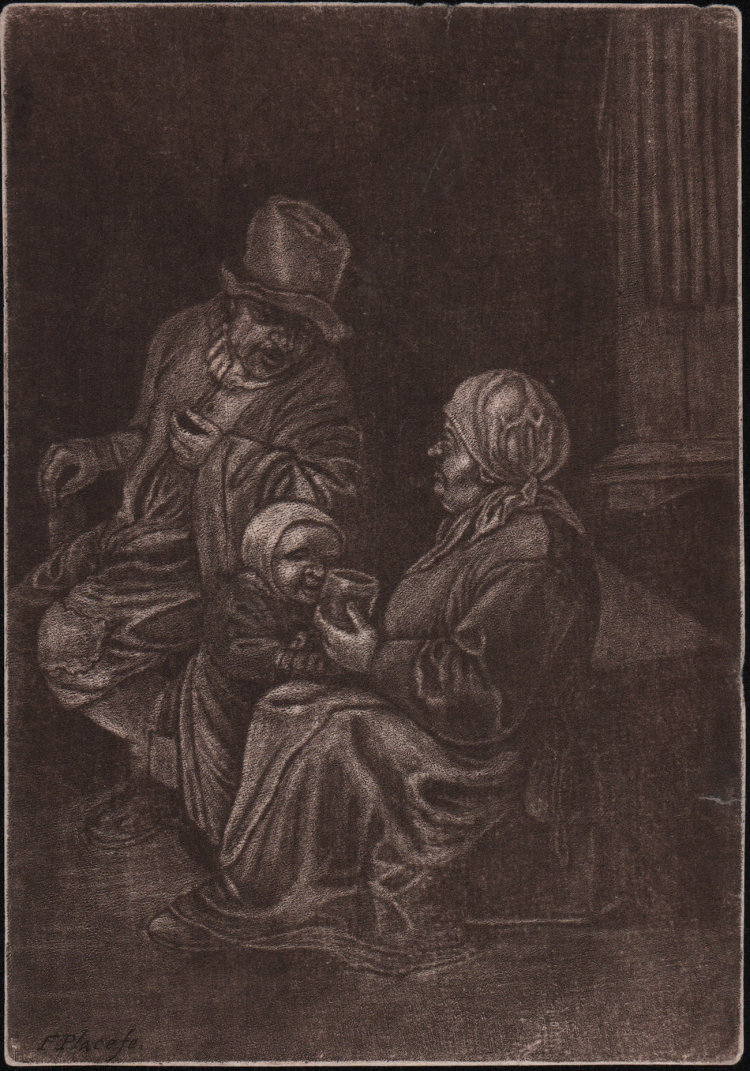



| Reference: | S42023 |
| Author | Francis PLACE |
| Year: | 1700 ca. |
| Measures: | 110 x 155 mm |


| Reference: | S42023 |
| Author | Francis PLACE |
| Year: | 1700 ca. |
| Measures: | 110 x 155 mm |
A Dutch family sitting on a bench facing left, the man twisting to talk to the woman, who sits holding a cup with a child standing at her knee, looking at it; a fluted pillar behind to right.
Mezzotint, circa 1700, signed at lower left.
Good impression on contemporary laid paper, trimmed to copperplate, small paper tear at lower right, traces of glue on verso, otherwise in good condition.
Francis Place (1647 - September 21, 1728) was an English draughtsman, potter, engraver and printmaker, active mainly in York. He was introduced to drawing and engraving by his close friend Wenceslaus Hollar. Around 1680, Place's interests and activities expanded further, as he joined the antiquarian group of virtuosi in York, where he eventually settled. Place's virtuosity and enthusiasm led him to experiment with oil painting beginning in 1680, stoneware glazing, and porcelain production beginning in 1683, which he abandoned in 1694 because of poor commercial success.
Bibliografia
Hake 1921/Some contemporary records relating to Francis Place, with a catalogue of his engraved work (223); Chaloner Smith 1883 / British Mezzotinto portraits from the introduction of the art to the early part of the present century (p. 1000).
Francis PLACE (1647 – 21 September 1728)
|
Francis Place (1647 – 21 September 1728) was an English gentleman draughtsman, potter, engraver and printmaker, active mainly in York. He was the fifth son of Rowland Place (1616–1680) of Dinsdale, county Durham, and his wife, Catherine (died 1670), daughter and coheiress of Charles Wise of Copgrove, Yorkshire. Place entered law as his father had done, and was articled to an attorney at Gray's Inn until the outbreak of the plague forced him to leave both the profession and London in 1665. By this time, Place had already discovered a gift for drawing and engraving through his close friend Wenceslaus Hollar. About 1680 Place's interests and activities widened further as he became involved with the antiquarian group the York virtuosi, where he eventually settled. Place became a friend of many artists and antiquarians in and around York, including Ralph Thoresby and William Lodge, with whom Place went on many drawing and angling excursions. As a result of the Popish Plot, during one trip to Wales, Place and Lodge found themselves imprisoned as suspected Jesuit spies. Place's virtuosity and enthusiasm led him to experiment with oil painting from 1680, stoneware pottery glazing, and the manufacture of porcelain from 1683, which he abandoned in 1694 owing to his lack of commercial success. Only four of his marbled greyware pots are known to have survived, one of which is in the Victoria and Albert Museum, London. About 1680 Place married Mrs Ann Wintringham, with whom he had one daughter, Elizabeth; presumably his wife died, and he married Mrs Ann Wilkinson (1662/1663–1752) in 1693, with whom he had two daughters, Ann and Frances. Place painted himself in oil, possibly at the time of this second marriage (Arbroath collection). He died at his home, King's Manor, York, on 21 September 1728, aged eighty-one, and was buried in St Olave's Church, York.
|
Francis PLACE (1647 – 21 September 1728)
|
Francis Place (1647 – 21 September 1728) was an English gentleman draughtsman, potter, engraver and printmaker, active mainly in York. He was the fifth son of Rowland Place (1616–1680) of Dinsdale, county Durham, and his wife, Catherine (died 1670), daughter and coheiress of Charles Wise of Copgrove, Yorkshire. Place entered law as his father had done, and was articled to an attorney at Gray's Inn until the outbreak of the plague forced him to leave both the profession and London in 1665. By this time, Place had already discovered a gift for drawing and engraving through his close friend Wenceslaus Hollar. About 1680 Place's interests and activities widened further as he became involved with the antiquarian group the York virtuosi, where he eventually settled. Place became a friend of many artists and antiquarians in and around York, including Ralph Thoresby and William Lodge, with whom Place went on many drawing and angling excursions. As a result of the Popish Plot, during one trip to Wales, Place and Lodge found themselves imprisoned as suspected Jesuit spies. Place's virtuosity and enthusiasm led him to experiment with oil painting from 1680, stoneware pottery glazing, and the manufacture of porcelain from 1683, which he abandoned in 1694 owing to his lack of commercial success. Only four of his marbled greyware pots are known to have survived, one of which is in the Victoria and Albert Museum, London. About 1680 Place married Mrs Ann Wintringham, with whom he had one daughter, Elizabeth; presumably his wife died, and he married Mrs Ann Wilkinson (1662/1663–1752) in 1693, with whom he had two daughters, Ann and Frances. Place painted himself in oil, possibly at the time of this second marriage (Arbroath collection). He died at his home, King's Manor, York, on 21 September 1728, aged eighty-one, and was buried in St Olave's Church, York.
|